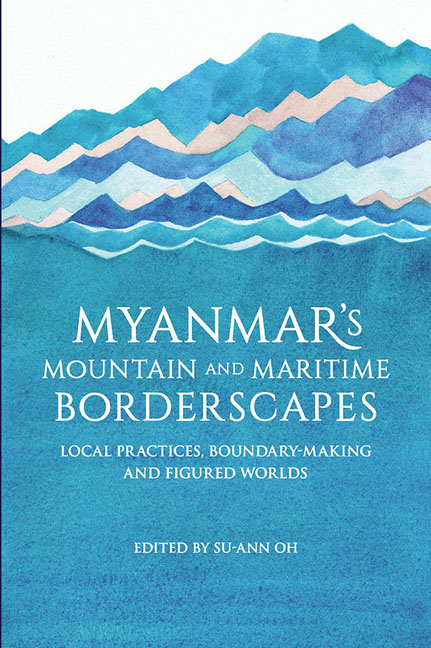Book contents
- Frontmatter
- Contents
- List of Tables
- List of Figures
- Acknowledgements
- Notes on Language, Terminology and Geographical Names
- Contributors
- Abbreviations
- 1 Introduction
- I Overview of Myanmar's Mountain and Maritime Borderscapes
- II Territorial Claims and Imagined Boundaries
- 4 Burman Territories and Borders in the Making of a Myanmar Nation State
- 5 Ritual and the Other in Rakhine Spirit Cults
- 6 Rohingya Territoriality in Myanmar and Bangladesh: Humanitarian Crisis and National Disordering
- III Social Organization and Border Economies
- IV Mobile Practices and Moving Borders
- V Identity Construction and the Politics of Belonging
- VI Institutionalized Identity and Border Practices
- Index
6 - Rohingya Territoriality in Myanmar and Bangladesh: Humanitarian Crisis and National Disordering
from II - Territorial Claims and Imagined Boundaries
Published online by Cambridge University Press: 06 June 2017
- Frontmatter
- Contents
- List of Tables
- List of Figures
- Acknowledgements
- Notes on Language, Terminology and Geographical Names
- Contributors
- Abbreviations
- 1 Introduction
- I Overview of Myanmar's Mountain and Maritime Borderscapes
- II Territorial Claims and Imagined Boundaries
- 4 Burman Territories and Borders in the Making of a Myanmar Nation State
- 5 Ritual and the Other in Rakhine Spirit Cults
- 6 Rohingya Territoriality in Myanmar and Bangladesh: Humanitarian Crisis and National Disordering
- III Social Organization and Border Economies
- IV Mobile Practices and Moving Borders
- V Identity Construction and the Politics of Belonging
- VI Institutionalized Identity and Border Practices
- Index
Summary
An estimated two million Muslim Rohingya live in the region surrounding the 200-kilometre long border between Bangladesh and Myanmar. The history of the population in reference to this border remains a contentious issue, as in both countries they represent a political challenge to, in Liisa Malkki's influential phrasing, “the national order of things” (Malkki 1995, p. 495). The large-scale denial of the Rohingya's claims to territory or belonging in either country betrays the uneasy fit between nation, state, and the interstate order. Both countries adhere to what Amena Mohsin has aptly described as the French, “state-centred and assimilationist” model of nationhood (Mohsin 1997, p. 2). Such a drive towards forging culturally homogenous nations in turn forces claims made by minorities into a particular political idiom: as “new nations” requiring a state of their own. However, in both Bangladesh and Myanmar, the Rohingya have been excluded even from the assimilation process, effectively being cast out of both nations and states.
Myanmar's stateless Rohingya minority is estimated to number approximately two million, hundreds of thousands of whom have fled to neighbouring Bangladesh. Bangladesh has been wary of accepting these immigrants, arguing first that they contribute to an extant situation of overpopulation and resource scarcity, and that they do not fit within the nationalist project of Islamic Bengaliness. In the last few years these tensions have reached a breaking point, leading to outbreaks of ethnically-based violence in Bangladesh and Myanmar between Muslim Rohingya and Buddhist Rakhine. As ethnic and communal homogeneity and territorial integrity have served as the ideal but impossible core of contemporary nationalisms in Myanmar and Bangladesh, these conflicts resonate beyond their immediate contexts.
This chapter argues that the Rohingya (as well as the Rakhine, the majority population in Rakhine State, of whom a significant number are currently living in Bangladesh) have been configured in changing ways through state-making projects over time. They have been enlisted in various projects of regional development in multiple capacities: in the case of the Rohingya, as labourers and surplus population, while the Rakhine were relocated as settlers and landowners.
- Type
- Chapter
- Information
- Myanmar's Mountain and Maritime BorderscapesLocal Practices, Boundary-Making and Figured Worlds, pp. 146 - 168Publisher: ISEAS–Yusof Ishak InstitutePrint publication year: 2016

